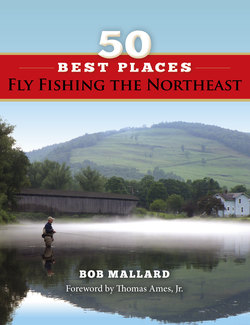Читать книгу 50 Best Places Fly Fishing the Northeast - Bob Mallard - Страница 32
На сайте Литреса книга снята с продажи.
ОглавлениеGreg Bostater with Ripogenus Gorge landlocked salmon. Seneca Love
is a series of drops, rapids, and runs, interrupted by deep pools and long tailouts. The Big Eddy is the most famous pool on the river. Below the eddy, the river widens into a series of riffles, runs, small rapids, and long pools before reaching Big Ambejackmockamus Falls. This begins a 2-mile stretch of Class III water known as Horserace, which terminates at Nesowadnehunk Deadwater. Below here is Class IV Nesowadnehunk Falls. Starting just downstream of the falls begins Abol Deadwater, which runs to Abol Bridge.
The river opens to fishing April 1. As a result of runoff, fishing does not pick up for several weeks. The best fishing runs from around Memorial Day through September, when the season ends. The section from Ripogenus Dam to the Telos Bridge is restricted to fly fishing only. There is a one-fish limit on salmon, with a minimum length of 26 inches. From Telos Bridge downstream to the red markers at the head of Pockwockamus Falls, tackle is restricted to single-hook artificial lures only. The limit on salmon is one fish. The minimum length limit is 18 inches. From August 16
Chris McMullen fishing the Cribwork. Maine River Guides
through September 30, the entire section is restricted to fly fishing only.
The average salmon on the West Branch runs between 12 and 16 inches. Fish between 18 and 20 inches are not uncommon. Fish over 20 inches are always a possibility. Brook trout average 8 to 12 inches. Trout up to 18 inches are possible, yet rare.
Hatches: Salmon and trout on the West Branch feed on smelt, dace, insects, crayfish, eggs, and worms. Insects include mayflies, caddis, stoneflies, and midges. Fish will feed on sucker eggs in the spring, and on salmonid eggs in the fall. Smelt are the most important food source on the West Branch. They enter the upper river via Ripogenus Dam. The lower river gets a spawning run of smelt in the spring from Ambajejus Lake.
Mayfly hatches begin in late May, with Blue-winged Olives, Quill Gordons, and Hendricksons. Stoneflies start around Memorial Day, and run all season. There are Yellow Sallies, Goldens, and occasionally Pteronarcys. March Browns, Sulphurs, and Cahills hatch in June.
Caddis hatches start in June, continuing well into September. Netspinners, Zebra Caddis, and Great Autumn Sedges are all present. Caddis hatches can be epic at times.
The West Branch is a big, brawling river. It can be intimidating for the wading angler not familiar with the river. The river can be floated. This is, however, best left to expert rowers who are familiar with the river. The West Branch is a great dry-fly fishery. Early in the season, streamer fishing with smelt patterns can be outstanding. Nymph fishing can be productive as well. The West Branch represents classic landlocked salmon fishing at its finest.
